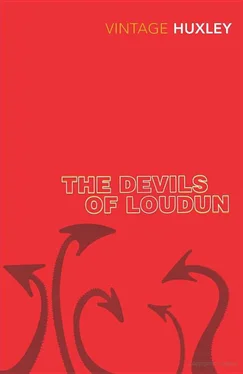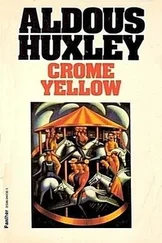The second point of difference is no less important than the first. To us, “matter” reveals itself as a something in perpetual activity—a something, indeed, whose essence is nothing other than activity. All matter is for ever doing something , and of all forms of matter the colloids composing living bodies are the most frantically busy—but with a frenzy marvellously integrated, so that the activity of one part of the organism regulates and in turn is regulated by the activities of other parts, in a harmonious dance of energies. For the ancients, and for mediaeval and early modern thinkers, matter was mere stuff, intrinsically inert, even in the living body where its activities were due exclusively to the workings of the vegetal soul in plants, of the vegetal and sensitive soul in the brutes, and, in man, of that trinity in unity, the vegetal, sensitive and rational soul. Physiological processes were explained not in terms of chemistry, for chemistry as a science was non-existent; nor in terms of electrical impulses, for nothing was yet known of electricity; nor in terms of cellular activity, for there was no microscope and nobody had ever seen a cell; they were explained (with no trouble at all) in terms of action on inert matter by special faculties of the soul. There was a faculty of growth, for example, a faculty of nutrition, a faculty of secretion—a faculty for any and every process that might be observed. For philosophers it was wonderfully convenient; but when men tried to pass from words to the given facts of nature, they found that the theory of special faculties was of no practical use whatever.
The crudity of the older materialism is clearly expressed in the language of its exponents. Physiological problems are discussed in metaphors drawn from what goes on in the kitchen, the smelter and the privy. There are boilings and simmerings and strainings; there are refinings and extractions; there are putrefactions, miasmic exhalations from the cesspool and their pestilential condensations upstairs, on the piano nobile . In terms such as these, fruitful thinking about the human organism is very difficult. The good doctors were men with a natural gift, who did not permit their learning to interfere too much with their diagnostic intuitions and their talent for helping nature to perform her miracles of healing. Along with much useless or dangerous nonsense, there is in Burton’s huge compilation not a little excellent sense. Most of the nonsense derives from the current scientific theories; most of the sense from the open-minded empiricism of shrewd and kindly men who loved their fellows, had a special knack with the sick and trusted in the vis medicatrix Naturae .
For details of the strictly medical treatment of melancholy, whether due to natural or supernatural causes, the reader is referred to Burton’s absurd and charming book. For our present purposes it is enough to remark that, during the whole time of the possession, Sœur Jeanne and her fellow nuns were under constant medical supervision. In their case, unfortunately, none of the more sensible methods of treatment described by Burton were ever applied. For them there was no question of a change of air, of diet, of occupation. They were merely bled and purged and made to swallow innumerable pills and draughts. So drastic was this medication that some of the independent physicians who examined them were of the opinion that their disease was aggravated (as so many diseases are still aggravated) by over-zealous attempts to bring about a cure. The nuns, they discovered, were being given large and frequent doses of antimony. Perhaps that was all that was wrong with them.
(To appreciate the full historical import of this diagnosis, we must bear in mind that, at the time of the possession, what may be called the Battle of Antimony had been raging for three generations and was still going strong. By the heretical anti-Galenists the metal and its compounds were regarded as miracle drugs, specific for practically everything. Under pressure from the orthodox right wing of the medical profession, the Parlement of Paris had issued an edict prohibiting their use in France. But the law had proved to be unenforceable. Half a century after its passage, Grandier’s good friend and Loudun’s most famous medical son, Théophraste Renaudot, was zealously proclaiming the virtue of antimony. His younger contemporary, Gui Patin, the author of the famous Letters , was no less violent on the other side. In the light of modern research we can see that Patin was more nearly in the right than Renaudot and the other anti-Galenists. Certain compounds of antimony are specific in the treatment of the tropical disease known as kala-azar. In most other conditions, the use of the metal or its compounds is hardly worth the risks involved. Medically speaking, there was no justification for such indiscriminate use as was made of the drug during the sixteenth and seventeenth centuries. From the economic point of view, however, the justification was ample. M. Adam and his fellow apothecaries sold Perpetual Pills of metallic antimony. These were swallowed, irritated the mucous membrane as they passed through the intestine, thus acting as a purgative, and could be recovered from the chamber pot, washed and used again, indefinitely. After the first capital outlay, there was no further need for spending money on cathartics. Dr. Patin might fulminate and the Parlement forbid; but for the costive French bourgeois the appeal of antimony was irresistible. Perpetual Pills were treated as heirlooms and after passing through one generation were passed on to the next.)
It is worth remarking parenthetically that Paracelsus, the greatest of the early anti-Galenists, owed his enthusiasm for antimony to a false analogy. “Just as antimony purifies gold and leaves no slag in it, in the same form and shape it purifies the human body.” [36]The same kind of false analogy between the arts of the metal-worker and the alchemist on the one hand and the arts of the doctor and dietician on the other led to the belief that the value of foods increased with their increasing refinement—that white bread was better than brown, that a much-stewed bouillon was superior to the unconcentrated meats and vegetables of which it was composed. It was assumed that ‘coarse’ foods coarsened the people who ate them. “Cheese, milk and oatcakes,” Paracelsus says, “cannot give one a subtle disposition.” It was only with the isolation of the vitamins, a generation ago, that the old false analogies with alchemy ceased to play havoc with our theories of diet.
The existence of a well-developed medical treatment of ‘melancholy’ was in no way incompatible with the existence of a widespread belief, even among the doctors, in the reality of possession and diabolic infestation. Some people, writes Burton, “laugh at all such stories.” But on the opposite side are “most lawyers, divines, physicians, philosophers.” Ben Jonson, in The Devil is an Ass , has left us a vivid description of the seventeenth-century mind, divided between credulity and scepticism, between a reliance on the supernatural (above all in its less creditable aspects) and a bumptious confidence in the new-found powers of applied science. In the play, Fitzdottrel is introduced as a dabbler in the magic arts, who longs to meet with a devil, because devils know the site of hidden treasures. But to this belief in magic and the power of Satan is conjoined a no less powerful belief in the quasi-rational and pseudoscientific schemes of those fraudulent inventors and company promoters whom our fathers called ‘projectors.’ When Fitzdottrel tells his wife that his projector has worked out a plan which will infallibly make him eighteen million pounds and secure him a dukedom, she shakes her head and tells him not to put too much trust “in these false spirits.” “Spirits!” cries Fitzdottrel,
Читать дальше











